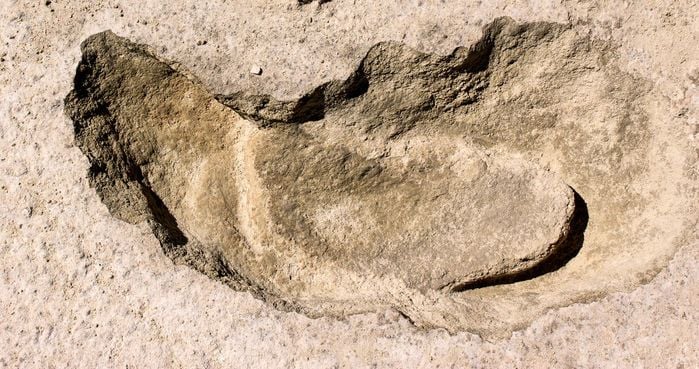Fossil Tracks May Record Ancient Humans Hunting Giant Sloths
The tracks suggest a human—perhaps in search of food—closely followed the movements of the massive creature
/https://tf-cmsv2-smithsonianmag-media.s3.amazonaws.com/filer/f7/d6/f7d64625-acb4-4372-924c-c3d1cc61562d/sloth_hunt.jpg)
New Mexico's White Sands National Monument is a desolate place; sparse vegetation pokes up throughout its salt flats and white gypsum dunes. But the area wasn't always a barren landscape. At the end of the last Ice Age, about 10,000 to 15,000 years ago, it was home to the massive Lake Otero. When the water receded, it opened up an area of expansive mudflats—a canvas to record tales of life at the lake.
Researchers recently identified a particularly curious tale: ancient humans tracking a giant sloth. As Ed Yong reports for The Atlantic, scientists spotted a set of giant sloth footprints with human prints nestled inside, suggesting that the ancient people were closely tailing the lumbering beast.
Last year, Matthew Bennett of Bournemouth University in the U.K. was excavating a set of the large apostrophe-shaped ground sloth tracks when he noticed a human print within one of them. Upon following the track, he found another double print, and another—eventually uncovering 10 in all.
The tracks suggest the human was following the sloth relatively closely, Yong reports. If the sloth was following the human, its massive footprint would have obliterated the human tracks. Conversely, if the human stepped into the sloth tracks at a later time—after the sloth tracks had dried—it would have left a distinctive pattern.
“It really does look like they were contemporaneous,” Anthony Martin, a trace fossil expert at Emory University tells Yong. “This is a common problem we have with dinosaur tracks: We have something that looks like following behavior, but could have been offset by days or weeks. Here, the humans maybe had the sloth in sight.” The research appears in the journal Science Advances.

The larger question is what, exactly, the stone-age human was doing tracking the beast. Ground sloths were very different from the ugly-cute meme-bait tree sloths we have today. These muscular giants had fierce claws and ranged in size from something akin to a golf cart to the size of an elephant.
If humans actually hunted them, it would have had to be a team effort. In this most recent paper, Bennett and his co-authors suggest just that. While most ground sloth tracks move in fairly straight or curving lines, the track with the human prints zig-zag, which means that the animal may have been trying to avoid hunters. As Yong reports, another set of human prints—which were much fainter, as if the person was moving on tiptoes—approaches from the opposite direction. At the end of the sloth track the sloth prints move in a circle, and there are claw marks on the ground, which the researchers interpret as the sloth rearing up on its hind legs and flailing its claws around.
Bennett’s team interprets the prints as hunting ambush. “While it was being distracted and turning, somebody else would come across and try and deliver the killer blow,” he tells Matthew Stock at Reuters. “It’s an interesting story and it’s all written in the footprints.”
William Harcourt-Smith, a paleoanthropologist at Lehman College and the American Museum of Natural History tells Laura Geggel at LiveScience that the study is well done, but there are potential alternative explanations. It’s a little odd and seems unnecessary that the pursuer step directly in the sloth prints, which would have required a much wider than normal stride. It could just be a human goofing around. “How many times have children, or even adults, followed in the footsteps of others in the snow or sand, simply for the fun of it?” he asks.
Bennett acknowledges that’s a possibility. “It’s really difficult to rule that out,” he tells Yong. “But I think that’s highly unlikely. These were fearsome animals. They had claws like Wolverine. I wouldn’t have wanted to go head-to-head with one. It would be a very silly risk to take.”
As Sid Perkins at Science reports, the tracks also add to the long debate about whether the mass disappearance of megafauna, including mammoth, giant sloths, sabre-toothed cats, giant armadillos, giant beavers and other huge animals went extinct because of the changing climate or if human hunting pushed them over the edge.
While some researchers doubt that humans with stone-tipped spears could successfully hunt some of these creatures, a 2016 study in Science Advances suggests that the one-two punch of a rapidly changing climate and human hunting pressure ended the age of giants. The new study certainly isn't conclusive proof of the link, but it at least places humans and megafauna in the same place at the same time.
White Sands may eventually reveal even more interesting interactions. The site contains hundreds of thousands of tracks, Bennett tells Geggel. It is likely the largest palimpsest of human and animal activity found in North America—and perhaps the world.
Editor's note April 30, 2018: An earlier version of this article mistakenly stated the human footprint was 20 inches long. The human footprints are around 5 inches long while the sloth prints are up to 22 inches long.